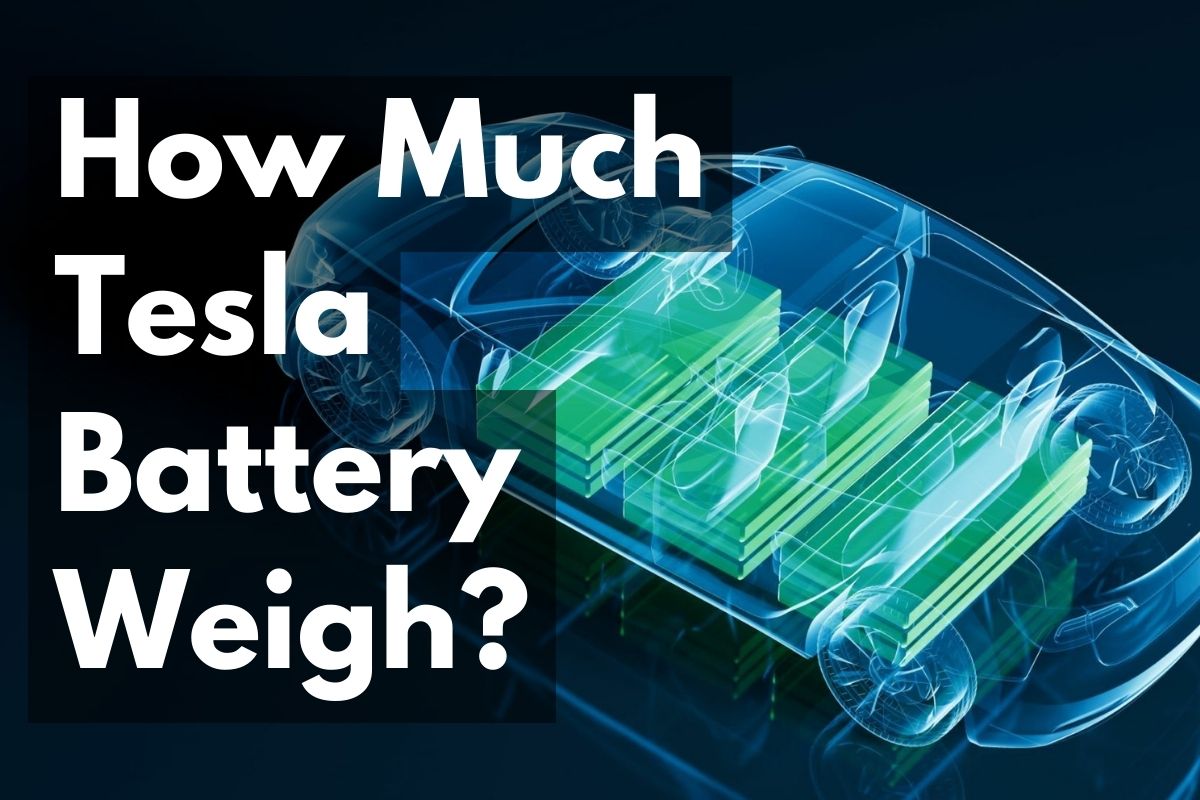The weight of Tesla battery packs varies across models. The Tesla Model 3 rocks the lightest pack, cruising in at about 1,060 pounds (lbs), while the Tesla Model Y takes the heavyweight title with batteries tipping the scales at 1,700 lbs. The model S weighs around 1200 pounds and the model X weigh around 1183 pound.
Tesla’s commitment to electric vehicle innovation is evident in every aspect of its design, especially its batteries. As the powerhouse of any electric vehicle (EV), a battery’s weight is crucial both for performance and efficiency. Tesla batteries, designed with both energy density and safety in mind, are a marvel in the EV industry.
They are sizable energy storage units, engineered to propel the vehicle over significant distances on a single charge. These lithium-ion powerhouses balance the need for durability, capacity, and weight efficiency, which directly impacts the range and handling of Tesla vehicles. For owners and enthusiasts alike, understanding the weight of these batteries is key to appreciating the high level of engineering that goes into building a Tesla.
Understanding Tesla Batteries

Tesla, a powerhouse in the electric vehicle market, relies on advanced battery technology to power its environmentally friendly cars. A key aspect that often piques the curiosity of owners and enthusiasts alike is the weight of a Tesla battery. The weight significantly impacts the vehicle’s performance, handling, and overall efficiency. Different models of Tesla cars use various battery packs, which affect the weight and driving range. Let’s delve deeper into the composition and types of Tesla batteries to understand what goes into these sophisticated power units.
Battery Composition
The robust energy source of a Tesla lies within its lithium-ion battery pack. This comprises individual cells arranged into modules and packs. Tesla’s dedication to innovation is evident in its battery composition, which includes:
- Electrodes: The anode and cathode, terminals through which current flows.
- Electrolytes: The medium providing the movement of lithium ions.
- Separators: These provide a barrier between the anode and cathode while allowing ions to pass through.
- Aluminum and steel casing: This houses the cells, ensuring durability.
These components are meticulously designed and assembled to create a battery that not only powers the vehicle efficiently but is also lightweight relative to its power output. Yet, despite these efforts, the battery remains the heaviest part of an electric vehicle, with Tesla’s batteries reaching hefty weights that can surpass 1,200 pounds depending on the model.
Battery Types
Tesla has continued to evolve its battery technology, offering several types to meet varying performance needs:
- Standard Range: These batteries offer a balance between affordability and range.
- Long Range: Designed for extended travel, they provide a significantly higher range.
- Performance: These batteries maximize power and acceleration for a thrilling driving experience.
Each battery type is tailored for specific models like the Tesla Model S, Model 3, Model X, and Model Y. The weights differ according to the energy capacity and range, with the Long Range and Performance variants generally being heavier due to their increased energy storage capability. Understanding the variation in battery types is crucial for potential buyers, as the battery not only impacts the vehicle’s price and weight but also its range and performance.
Tesla’s ongoing quest for improved battery technology is focused on reducing weight while enhancing range and longevity. Future batteries may incorporate new materials and designs that challenge the current weight norms for electric vehicle batteries, pushing the boundaries of what’s possible with electric propulsion.
Tesla Battery Weights
Understanding the weight of Tesla’s groundbreaking battery systems is pivotal for both potential Tesla owners and tech enthusiasts alike. These batteries aren’t just the heart of each vehicle but also a marvel of modern engineering. Delving into the specifics, let’s explore the distinct battery weights across Tesla’s renowned models. Here, accurate figures will be provided for the Model S, Model 3, and Model X, allowing for a comprehensive comparison concerning the heft of these powerhouses.
Model S Battery Weight
The Tesla Model S is a blend of luxury and performance, powered by a substantial battery pack. Its battery is designed for efficiency and to enhance the vehicle’s overall balance and handling. The battery weight for the Model S comes in at approximately 1,200 pounds (544 kg). This heft contributes to the low center of gravity of the vehicle, which promotes driving stability and safety.
Model 3 Battery Weight
As the most popular and affordable option in the Tesla lineup, the Model 3 boasts an impressive battery that delivers both range and responsive power. The current generation Model 3 battery weighs in at a sleeker around 1,060 pounds (480 kg), showcasing Tesla’s continuous efforts in battery development and weight optimization.
Model X Battery Weight
When discussing the Tesla Model X, it’s critical to recognize its status as a premier electric SUV with an emphasis on performance. Its larger frame and capacity are mirrored in its battery weight. The Model X’s powerful battery pack tips the scales at roughly 1183 pounds (536kg), a statement of its robustness and endurance on the road.
Tesla Model Y Battery Weight
Tesla Model Y has the heaviest battery which tips the scales at a formidable 1,700 pounds (771kg). This robust battery system plays a crucial role in powering the Model Y, providing the necessary energy for its electric propulsion system. The weight of the batteries underscores the impressive energy storage capacity and technological advancements employed by Tesla, contributing to the vehicle’s overall performance and range. With its hefty yet sophisticated power source, the Tesla Model Y stands as the heavyweight electric vehicle.
| Model | Battery Weight |
| Model S | 1,200 lbs (544 kg) |
| Model 3 | 1,060 lbs (480 kg) |
| Model X | 1,183 lbs (536 kg) |
| Model Y | 1,700 lbs (771kg) |
Comparing these weights highlights the nuanced balance between vehicle size, battery capacity, and overall performance. Tesla’s innovative approach to battery technology ensures that each model delivers an optimized blend of weight and power, contributing to the brand’s unmatched driving experience.
Factors Affecting Battery Weight
Understanding the heft of a Tesla battery is critical for several reasons, ranging from vehicle performance to shipping logistics. However, it’s important to note that the weight of a Tesla battery can vary significantly, and this happens due to several key factors. Let’s dive into what influences the battery weight, ensuring your knowledge is as charged as the batteries themselves!
The weight of a Tesla battery is not a static figure; instead, it fluctuates based on various elements intrinsic to the battery’s design and composition. Identifying these factors is essential for anyone interested in electric vehicles (EVs) or the mechanics of Tesla’s pioneering technology.
Battery Capacity
The capacity of a Tesla battery is directly proportional to its weight. Batteries with higher capacity contain more energy and, consequently, tend to weigh more. This is because they have more cells, which are the building blocks of any battery.
- Tesla Model S: features a battery with a substantial capacity, leading to a higher total weight.
- Tesla Model 3: the standard range variant has a lower-capacity battery, making it lighter in comparison.
Battery Chemistry
Beyond mere capacity, the chemical makeup of a battery is a principal factor in determining its weight. As Tesla continues to evolve its battery technology, changes in the chemical composition can result in varying weights.
Currently, Tesla uses lithium-ion batteries, but within this category, there are differences:
- Nickel-Cobalt-Aluminum (NCA): Typically lighter, used in many Tesla vehicles.
- Nickel-Manganese-Cobalt (NMC): Often found in energy storage products and some EV models, these can be heavier due to the different material densities.
The transition to new chemistry like the 4680 cell format, with its reduced cobalt content and efficient use of space, aims to lighter yet more energy-dense batteries.
Tesla’s research into battery chemistry and continual advancements suggest that battery weight could potentially decrease in the future while maintaining or even increasing battery capacity.
Frequently Asked Questions On How Much Does A Tesla Battery Weigh
Is A Tesla Battery Heavier Than An Engine?
Yes, a Tesla battery is typically heavier than a conventional car engine, due to the dense energy storage cells it contains.
How Heavy Are The Batteries In A Tesla?
Tesla car batteries typically weigh between 1,200 to 1,800 pounds (540 to 815 kilograms), depending on the model.
Is A Tesla Heavier Than A Regular Car?
Yes, Tesla vehicles are generally heavier than traditional cars due to their battery packs.
What Is The Tesla Model S Battery Weight?
The Tesla Model S battery pack weighs approximately 1,200 pounds (544 kg).
Conclusion
Understanding the weight of a Tesla battery is crucial for both potential buyers and electric vehicle enthusiasts. Tesla’s advanced battery technology ensures a balance between efficiency and performance. Whether considering a Model S, X, 3, or Y, the battery is a marvel of modern engineering.
Remember, the exact weight varies across models, enhancing the driving experience in unique ways. Keep this in mind as you weigh your electric vehicle options.




